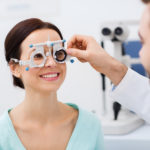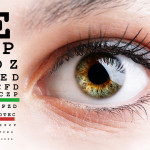By David Blyweiss, M.D., Advanced Natural Wellness
March 14, 2022
“Eating and reading are two pleasures that combine admirably.” — C. S. Lewis
I wholeheartedly agree with that sentiment. Sitting down to dinner with a good book on my table stand is one of the highlights of my day… as well as during breakfast and lunch if I’m home.
I love to read, so the last thing I would ever want to experience is vision problems. The interesting thing here is that the foods we put into our mouths can have a direct effect on whether we experience vision loss or not.
For example, when you eat the wrong foods, you are three times more likely to develop age-related macular degeneration (AMD) over the next 18 years. Some of the worst foods for macular degeneration are processed and red meat, fried foods, processed foods, desserts, refined grains, high fat dairy and sugary beverages.
AMD is one of the scariest eye diseases you can get. It interferes with your sharp, central vision. So when you look straight ahead, things look blurred and distorted. This makes it difficult to read, drive and even recognize faces.
Worse, AMD is the leading cause of blindness in people over 60 years of age. And, to date, there is no cure for it. It’s not reversible.
MD Exposes the Hidden Danger to Your Eyes

When your eyesight starts to fail, it's a real problem. Suddenly you can't go to the grocery store... you can't get to the doctor if you have an emergency... you can't meet your friends for dinner…
Your "regular" doctor doesn't have time to keep up with the latest research. And the same goes for eye doctors. They go to school to learn how to fit you for glasses and contacts, but have no way of preventing the damage and loss of eyesight that threatens your freedom and independence.
Let me show you something that explains a LOT about how your eyes work.
In my FREE Special Report, I'll show you a HUGE, untapped resource for your eyes that safely and naturally restores clear, effortless eyesight.
Click here to get started...
So I’m pretty happy when I look from my book to my plate and realize how well I’m feeding my eyes.
The Best Foods for AMD
When I eat, I usually stick to a mostly rainbow-colored organic plant-based diet with some clean animal proteins included. All of these foods include nutrients that will allow me to keep up my vision strength for years to come.
Colorful vegetables are the centerpiece of my meals. Foods that are yellow, orange, red and deep green boost my lutein and zeaxanthin levels. These are two extremely important nutrients needed to maintain macular density, protect the macula from harmful UV light and shield your eyes from free radical damage.
Wild caught fish and shellfish grace my plate a few nights a week. They are high in both omega-3 fatty acids and taurine, which are essential to eye health. Some seafood, especially shellfish, also contains astaxanthin, which helps improve retinal function and visual acuity when combined with lutein and zeaxanthin.
The omega-3 fatty acids in seafood protect nerve cells in the retina by shutting down oxidative stress, inflammation and abnormal blood vessel formation. Taurine protects specialized cells that send the images you see to your brain.
Pastured meat and poultry are also sources of taurine, but should only account for a small portion of your diet.
Seeds, nuts and lentils get sprinkled into most of my meals. Many of them, such as pumpkin seeds, sesame seeds, cashews and lentils are good sources of zinc. This is another nutrient that feeds your eyes.
When you’re short on zinc, it makes it harder for your eyes to adjust to the dark. This makes it difficult to see things when you go from a well-lit area into a room that’s much darker – or turning off of a brightly lit highway onto a dark side street.
Are You Suffering From...
- Love handles and a pot belly
- Romance that isn't what it used to
- Forgetfulness and inattention
- Low (or no) strength and endurance
- A sex drive that's shifted into neutral...or worse
If so...you may have Mature Male Burnout. Click here to discover more about this unique condition and what you can do about it.
Grass fed beef and lamb also contain zinc, but should be eaten in moderation.
Also, I only eat the eggs of pastured chickens. The yolks of these eggs aren’t the pale-yellow color like those from commercially raised chickens. They’re bright orange and contain higher levels of healthy lutein, zeaxanthin, omega 3 fats and vitamins than conventional eggs.
What’s for Dessert?
I’m a big fan of eating fresh fruit for dessert. But when it comes to lowering your risk of AMD, citrus is the way to go.
Oranges, tangerines, lemons and grapefruit all contain powerful flavonoid called hesperidin that can help preserve your vision. As a matter of fact, we’ve found that people who eat at least one serving of oranges every day have more than a 60% reduced risk of developing late macular degeneration 15 years later.
I suspect that there are many reasons for this. Hesperidin is a potent antioxidant and free radical scavenger that can restore the health of injured nerve cells. Just as importantly, it appears to inhibit blood vessel growth which may help prevent leaky blood vessels behind the macula.
Plus citrus is high in vitamin C which, along with vitamins A and E, can make a big difference when it comes to preserving our eyesight or losing it. (This is where all of those antioxidant rich fruits, vegetables, nuts and seeds add an extra punch to protect your vision!)
So there you have it. If you feed your eyes well, they’ll help you keep doing the things you love to do for years to come…you’ll see.
SOURCES:
Dighe S, Zhao J, Steffen L, Mares JA, Meuer SM, Klein BEK, Klein R, Millen AE. Diet patterns and the incidence of age-related macular degeneration in the Atherosclerosis Risk in Communities (ARIC) study. Br J Ophthalmol. 2020 Aug;104(8):1070-1076.
Zhu W, Wu Y, Meng YF, Xing Q, Tao JJ, Lu J. Fish Consumption and Age-Related Macular Degeneration Incidence: A Meta-Analysis and Systematic Review of Prospective Cohort Studies. Nutrients. 2016 Nov 22;8(11):743.
Giannaccare G, Pellegrini M, Senni C, Bernabei F, Scorcia V, Cicero AFG. Clinical Applications of Astaxanthin in the Treatment of Ocular Diseases: Emerging Insights. Mar Drugs. 2020;18(5):239.
Castelli V, Paladini A, d’Angelo M, et al. Taurine and oxidative stress in retinal health and disease. CNS Neurosci Ther. 2021;27(4):403-412.
Age-Related Eye Disease Study Research Group. A randomized, placebo-controlled, clinical trial of high-dose supplementation with vitamins C and E, beta carotene, and zinc for age-related macular degeneration and vision loss: AREDS report no. 8 [published correction appears in Arch Ophthalmol. 2008 Sep;126(9):1251]. Arch Ophthalmol. 2001;119(10):1417-1436.
Smailhodzic D, van Asten F, Blom AM, Mohlin FC, den Hollander AI, van de Ven JP, van Huet RA, Groenewoud JM, Tian Y, Berendschot TT, Lechanteur YT, Fauser S, de Bruijn C, Daha MR, van der Wilt GJ, Hoyng CB, Klevering BJ. Zinc supplementation inhibits complement activation in age-related macular degeneration. PLoS One. 2014 Nov 13;9(11):e112682.
Gopinath B, Liew G, Tang D, Burlutsky G, Flood VM, Mitchell P. Consumption of eggs and the 15-year incidence of age-related macular degeneration. Clin Nutr. 2020 Feb;39(2):580-584.
Gopinath B, Liew G, Kifley A, Flood VM, Joachim N, Lewis JR, Hodgson JM, Mitchell P. Dietary flavonoids and the prevalence and 15-y incidence of age-related macular degeneration. Am J Clin Nutr. 2018 Aug 1;108(2):381-387.
Majumdar S, Srirangam R. Potential of the bioflavonoids in the prevention/treatment of ocular disorders. J Pharm Pharmacol. 2010;62(8):951-965.







